A Deep Learning Approach to Optimize Recombinant Protein Production in Escherichia coli Fermentations
Abstract
1. Introduction
2. Materials and Methods
2.1. Fermentations
2.1.1. Strain and Plasmid
2.1.2. Fermentations
2.1.3. Inclusion Body Recovery
2.2. Machine Learning Pipeline
2.2.1. Data Preparation
2.2.2. Deep Learning Model
- Fully connected layer;
- RNN/LSTM module;
- Fully connected layer.
3. Experiments
3.1. Setup
3.2. Evaluation Criteria
3.3. Evaluation Metrics
4. Results
5. Discussion
5.1. Production
5.2. ML Prediction Results
6. Conclusions
Supplementary Materials
Author Contributions
Funding
Institutional Review Board Statement
Informed Consent Statement
Data Availability Statement
Conflicts of Interest
Abbreviations
| CPP | Critical Process Parameters |
| DO | Dissolved Oxygen |
| GMP | Good Manufacturing Practices |
| LSTM | Long Short-Term Memory Network |
| ML | Machine Learning |
| OD600nm | Optical Density (at 600 nanometers) |
| REFY | Relative Error on Final Yield |
| RMSE | Root Mean Squared Error |
| RNN | Recurrent Neural Network |
| rpm | Rotation Per Minute |
| SGD | Stochastic Gradient Descent |
| UPLC | Ultra Performance Liquid Chromatography |
References
- Rosano, G.L.; Ceccarelli, E.A. Recombinant protein expression in Escherichia coli: Advances and challenges. Front. Microbiol. 2014, 5, 172. [Google Scholar] [CrossRef] [PubMed]
- Cai, J.; Hua, F.; Yuan, L.; Tang, W.; Lu, J.; Yu, S.; Wang, X.; Hu, Y. Potential Therapeutic Effects of Neurotrophins for Acute and Chronic Neurological Diseases. BioMed Res. Int. 2014, 2014, 601084. [Google Scholar] [CrossRef]
- Huang, E.J.; Reichardt, L.F. Neurotrophins: Roles in 26 neuronal development and function. Annu. Rev. Neurosci. 2001, 24, 677–736. [Google Scholar] [CrossRef] [PubMed]
- Rattenholl, A.; Lilie, H.; Grossmann, A.; Stern, A.; Schwarz, E.; Rudolph, R. The pro-sequence facilitates folding of human nerve growth factor from Escherichia coli inclusion bodies. Eur. J. Biochem. 2001, 268, 3296–3303. [Google Scholar] [CrossRef]
- Masoudi, R.; Ioannou, M.S.; Coughlin, M.D.; Pagadala, P.; Neet, K.E.; Clewes, O.; Allen, S.J.; Dawbarn, D.; Fahnestock, M. Biological activity of nerve growth factor precursor is dependent upon relative levels of its receptors. J. Biol. Chem. 2009, 284, 18424–18433. [Google Scholar] [CrossRef] [PubMed]
- Schimek, C.; Egger, E.; Tauer, C.; Striedner, G.; Brocard, C.; Cserjan-Puschmann, M.; Hahn, R. Extraction of recombinant periplasmic proteins under industrially relevant process conditions: Selectivity and yield strongly depend on protein titer and methodology. Biotechnol. Prog. 2020, 36, e2999. [Google Scholar] [CrossRef]
- Vanti, C.V.M.; Leite, L.C.; Batista, E.A. Monitoring and control of the processes involved in the capture and filtering of biogas using FPGA embedded fuzzy logic. IEEE Lat. Am. Trans. 2015, 13, 2232–2238. [Google Scholar] [CrossRef]
- Hansen, B.D.; Tamouk, J.; Tidmarsh, C.A.; Johansen, R.; Moeslund, T.B.; Jensen, D.G. Prediction of the Methane Production in Biogas Plants Using a Combined Gompertz and Machine Learning Model. Comput. Sci. Its Appl.—ICCSA 2020, 2020, 734–745. [Google Scholar]
- Manu, D.S.; Thalla, A.K. Artificial intelligence models for predicting the performance of biological wastewater treatment plant in the removal of Kjeldahl Nitrogen from wastewater. Appl. Water Sci. 2017, 7, 3783–3791. [Google Scholar] [CrossRef]
- Nourani, V.; Elkiran, G.; Abba, S.I. Wastewater treatment plant performance analysis using artificial intelligence—An ensemble approach. Water Sci. Technol. 2018, 78, 2064–2076. [Google Scholar] [CrossRef]
- Wang, L.; Long, F.; Liao, W.; Liu, H. Prediction of anaerobic digestion performance and identification of critical operational parameters using machine learning algorithms. Bioresour. Technol. 2020, 298, 122495. [Google Scholar] [CrossRef] [PubMed]
- Cinar, S.Ö.; Cinar, S.; Kuchta, K. Machine Learning Algorithms for Temperature Management in the Anaerobic Digestion Process. Fermentation 2022, 8, 65. [Google Scholar] [CrossRef]
- Helleckes, L.M.; Hemmerich, J.; Wiechert, W.; von Lieres, E.; Grünberger, A. Machine learning in bioprocess development: From promise to practice. Trends Biotechnol. 2022, 41, 817–835. [Google Scholar] [CrossRef]
- Khaleghi, M.K.; Savizi, I.S.P.; Lewis, N.E.; Shojaosadati, S.A. Synergisms of machine learning and constraint-based modeling of metabolism for analysis and optimization of fermentation parameters. Biotechnol. J. 2021, 16, 2100212. [Google Scholar] [CrossRef]
- Chen, F.; Li, H.; Xu, Z.; Hou, S.; Yang, D. User-friendly optimization approach of fed-batch fermentation conditions for the production of iturin A using artificial neural networks and support vector machine. Electron. J. Biotechnol. 2015, 18, 273–280. [Google Scholar] [CrossRef]
- Packiam, K.A.R.; Ooi, C.W.; Li, F.; Mei, S.; Tey, B.T.; Ong, H.F.; Song, J.; Ramanan, R.N. PERISCOPE-Opt: Machine learning-based prediction of optimal fermentation conditions and yields of recombinant periplasmic protein expressed in Escherichia coli. Comput. Struct. Biotechnol. J. 2022, 20, 2909–2920. [Google Scholar] [CrossRef]
- Nagata, Y.; Chu, K.H. Optimization of a fermentation medium using neural networks and genetic algorithms. Biotechnol. Lett. 2003, 25, 1837–1842. [Google Scholar] [CrossRef] [PubMed]
- Vinitha, N.; Vasudevan, J.; Gopinath, K.P. Bioethanol production optimization through machine learning algorithm approach: Biomass characteristics, saccharification, and fermentation conditions for enzymatic hydrolysis. Biomass Conv. Bioref. 2022. [Google Scholar] [CrossRef]
- Sherstinsky, A. Fundamentals of Recurrent Neural Network (RNN) and Long Short-Term Memory (LSTM) Network. Phys. D Nonlinear Phenom. 2020, 404, 132306. [Google Scholar] [CrossRef]
- Cavazza, J.; Ahmed, W.; Volpi, R.; Morerio, P.; Bossi, F.; Willemse, C.; Wykowska, A.; Murino, V. Understanding action concepts from videos and brain activity through subjects’ consensus. Sci. Rep. 2022, 12, 19073. [Google Scholar] [CrossRef]
- Rivera-Acosta, M.; Ruiz-Varela, J.M.; Ortega-Cisneros, S.; Rivera, J.; Parra-Michel, R.; Mejia-Alvarez, P. Spelling correction real-time american sign language alphabet translation system based on yolo network and LSTM. Electronics 2021, 10, 1035. [Google Scholar] [CrossRef]
- Wang, D.; Wang, X.; Lv, S. An overview of end-to-end automatic speech recognition. Symmetry 2019, 11, 1018. [Google Scholar] [CrossRef]
- Cui, W.; He, X.; Yao, M.; Wang, Z.; Li, J.; Hao, Y.; Wu, W.; Zhao, H.; Chen, X.; Cui, W. Landslide image captioning method based on semantic gate and bi-temporal LSTM. ISPRS Int. J. -Geo-Inf. 2020, 9, 194. [Google Scholar] [CrossRef]
- Bebis, G.; Georgiopoulos, M. Feed-forward neural networks. IEEE Potentials 1994, 13, 27–31. [Google Scholar] [CrossRef]
- Sammut, C.; Webb, G.I. Leave-one-out cross-validation. Encycl. Mach. Learn. 2010, 600–601. [Google Scholar] [CrossRef]
- Hyndman, R.J.; Koehler, A.B. Another look at measures of forecast accuracy. Int. J. Forecast. 2006, 22, 679–688. [Google Scholar] [CrossRef]
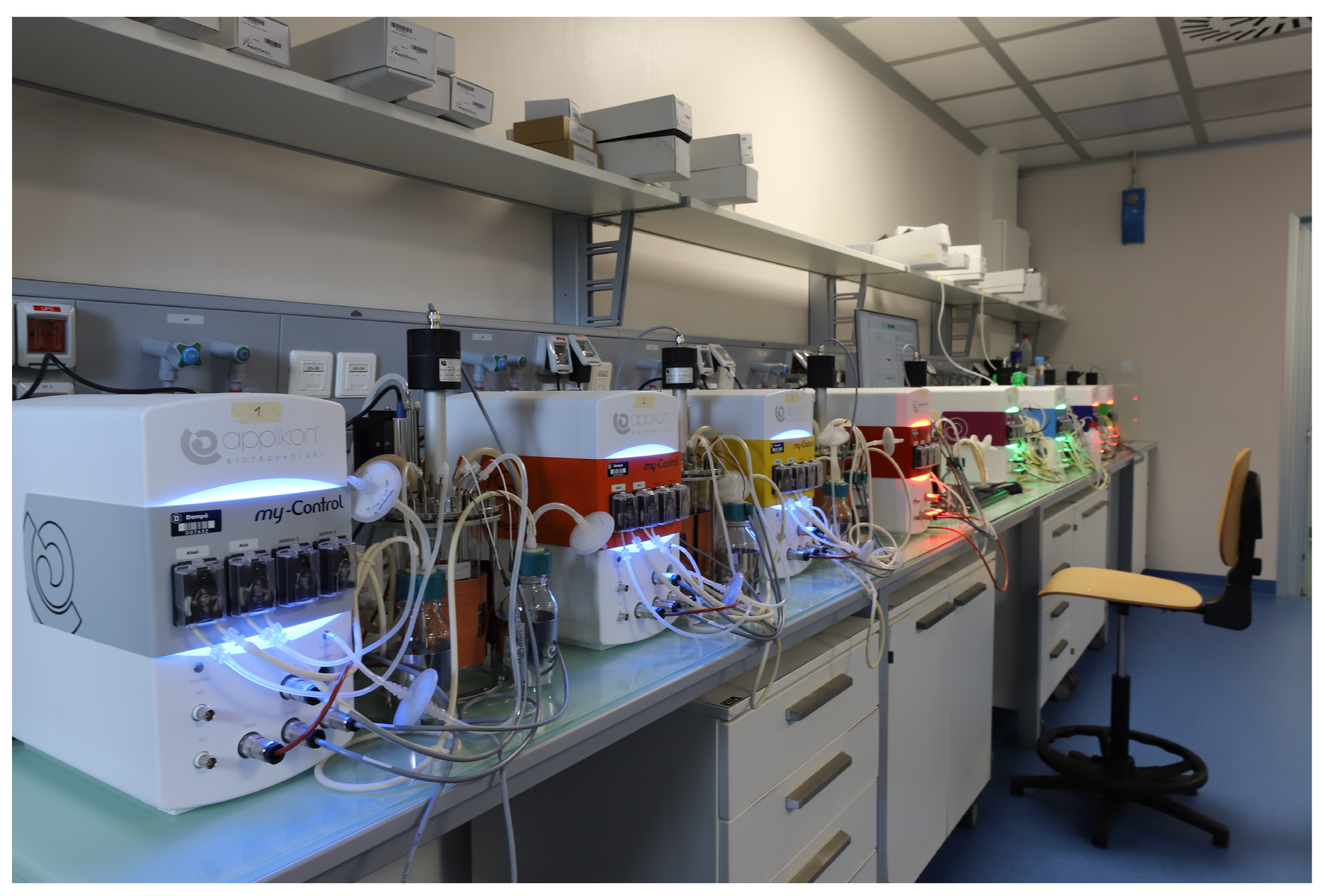
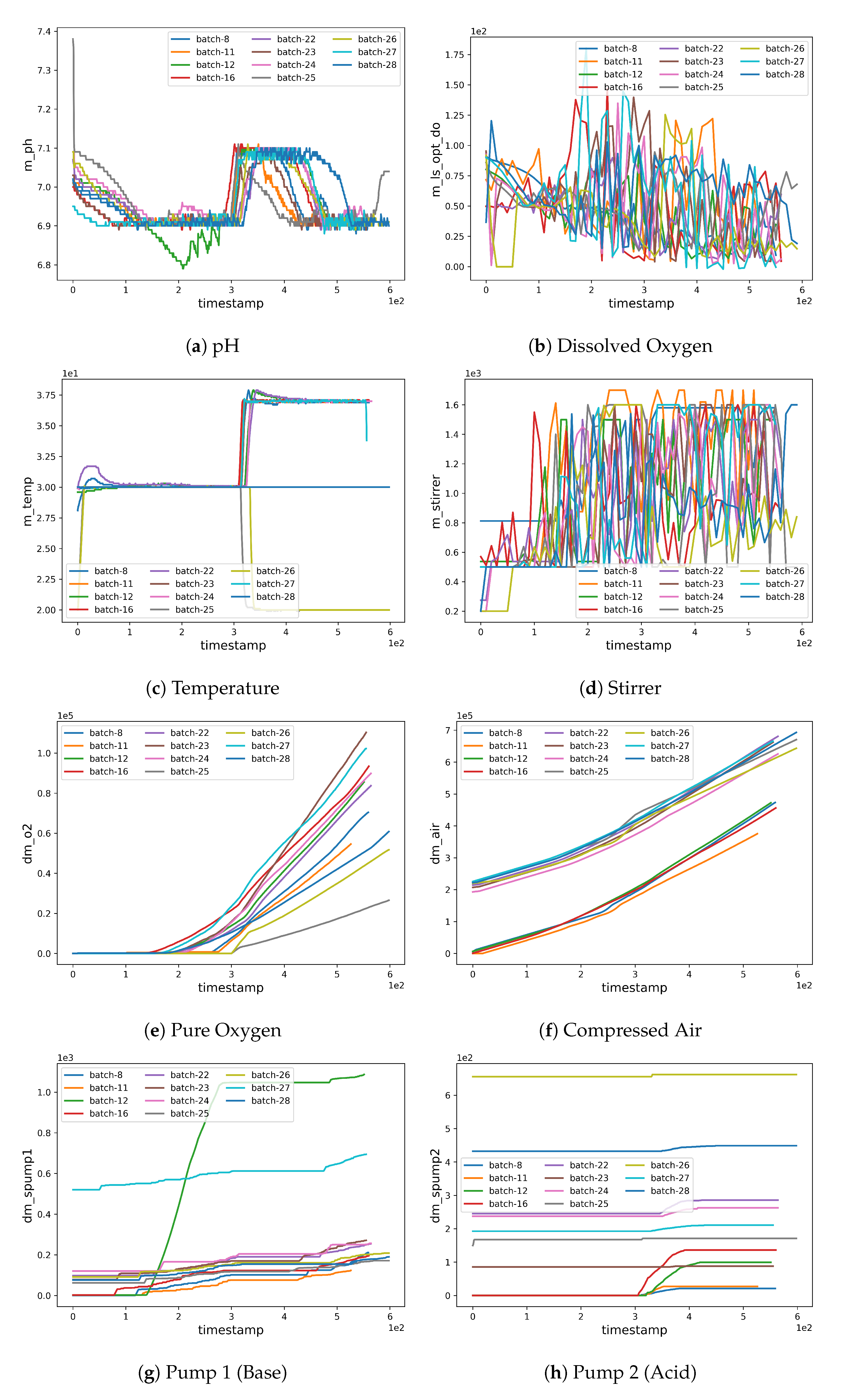

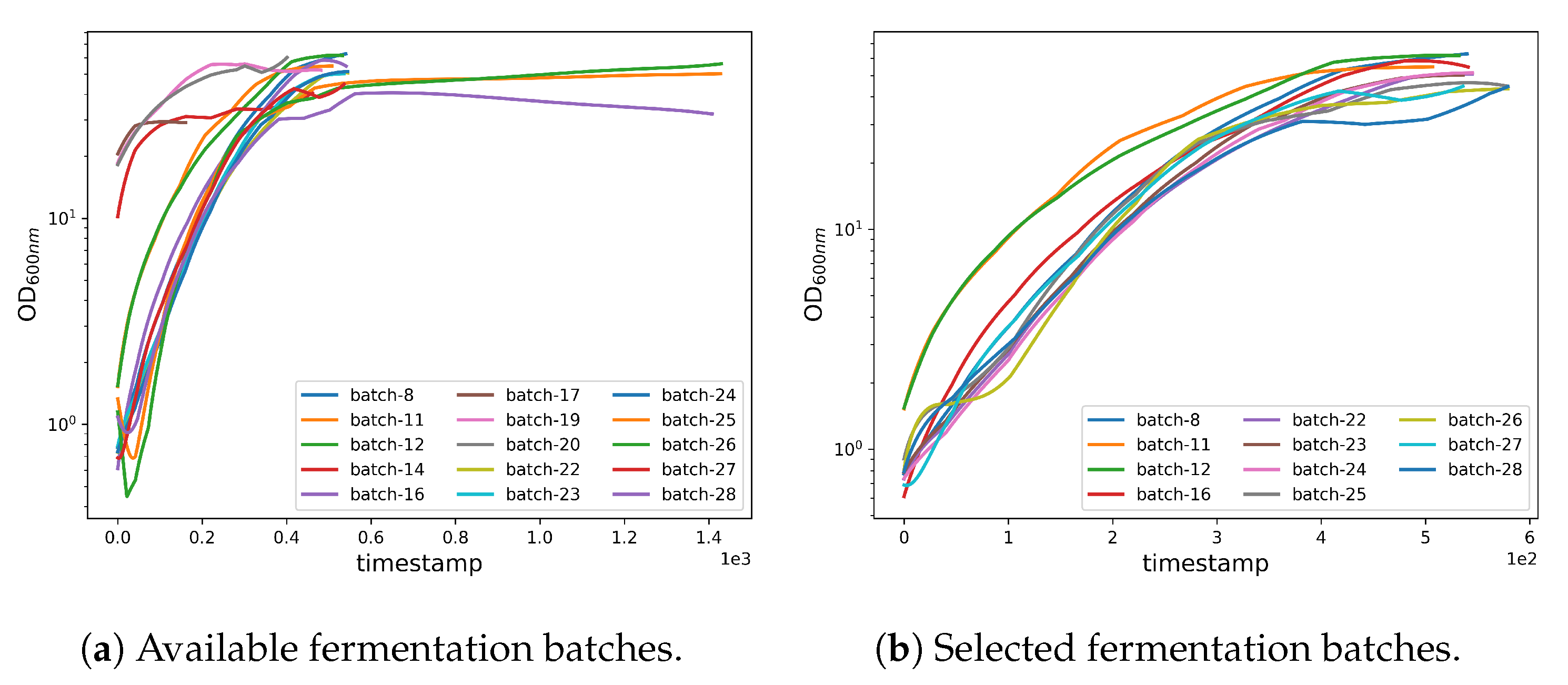
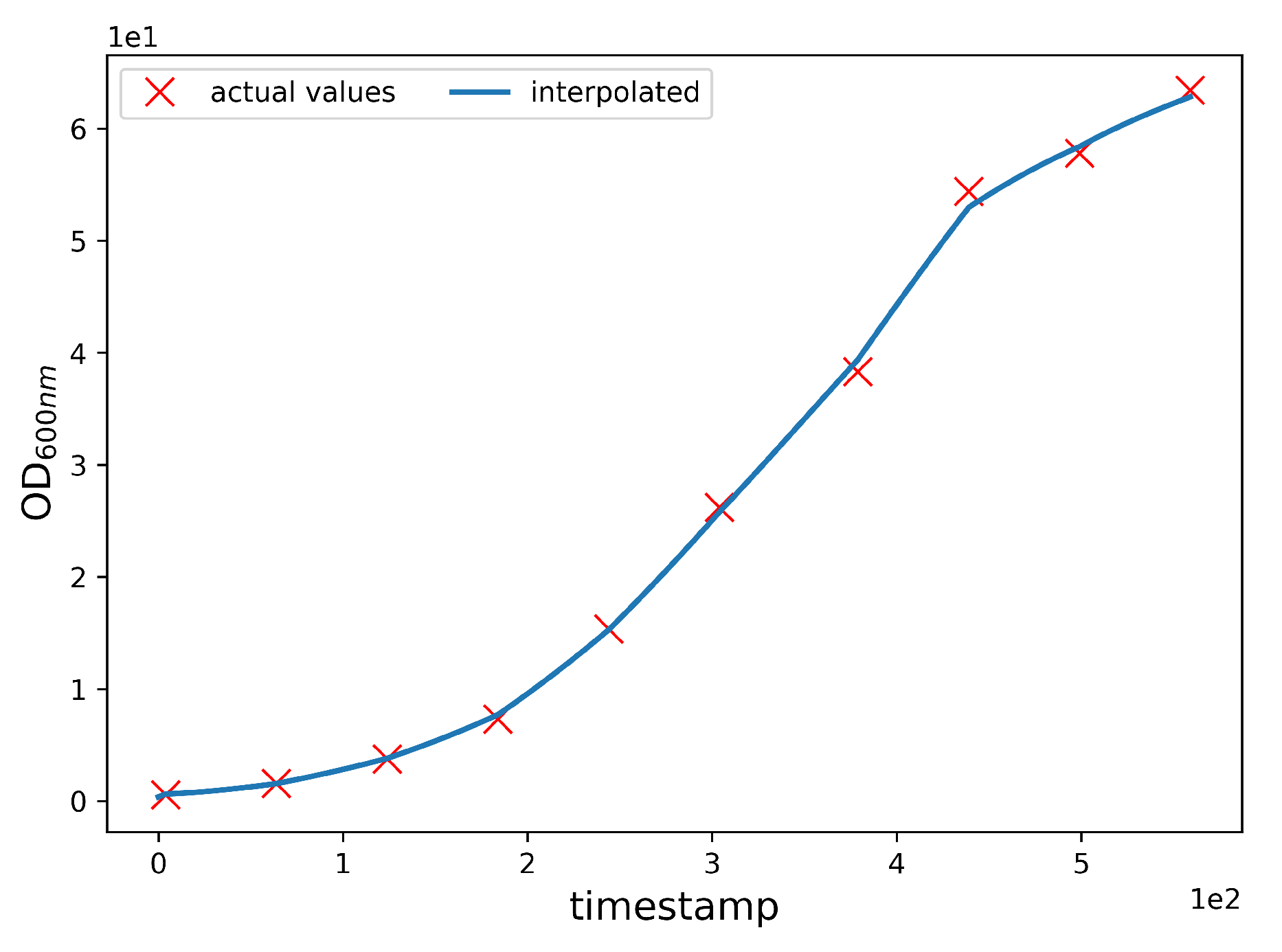
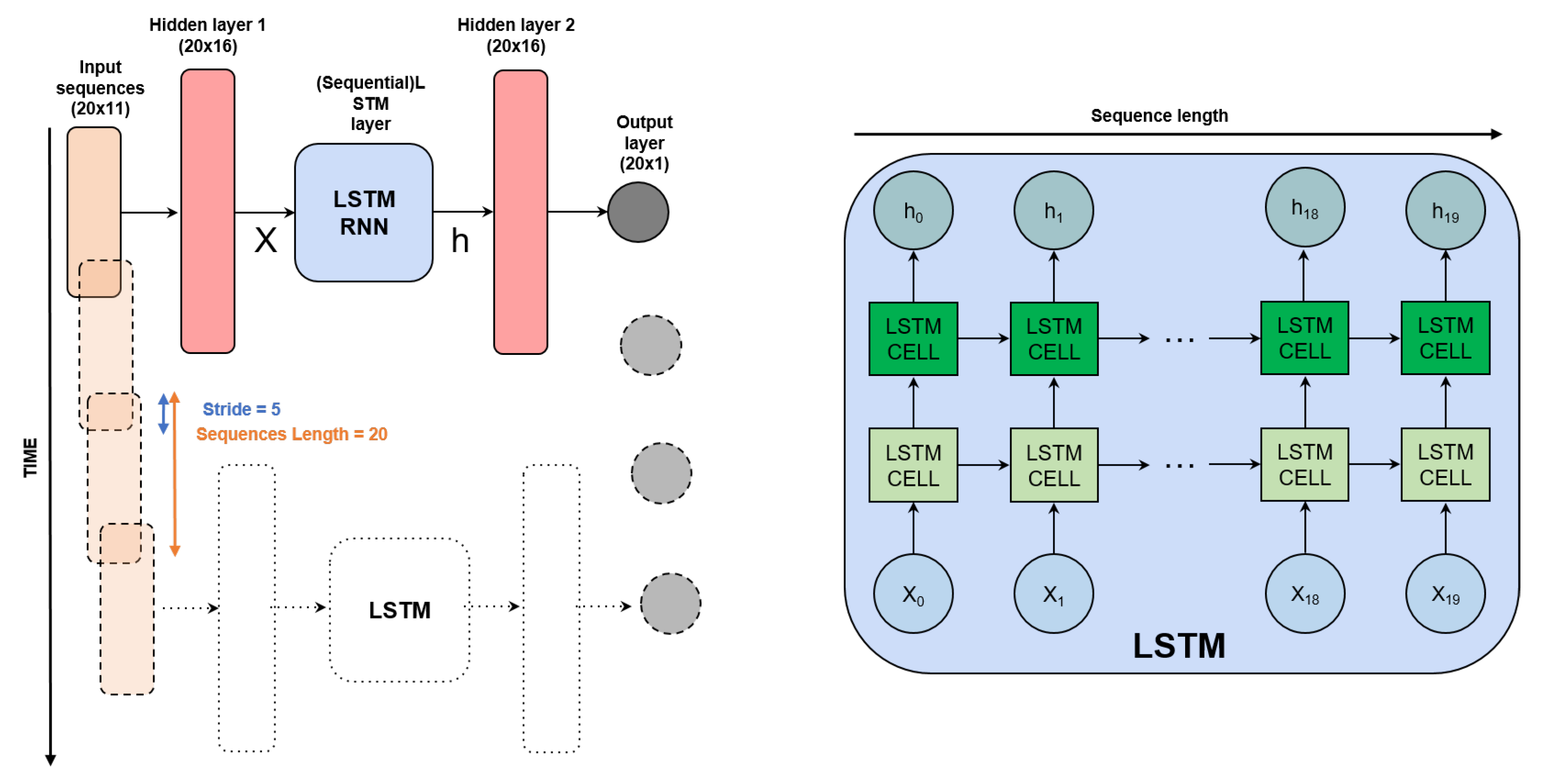
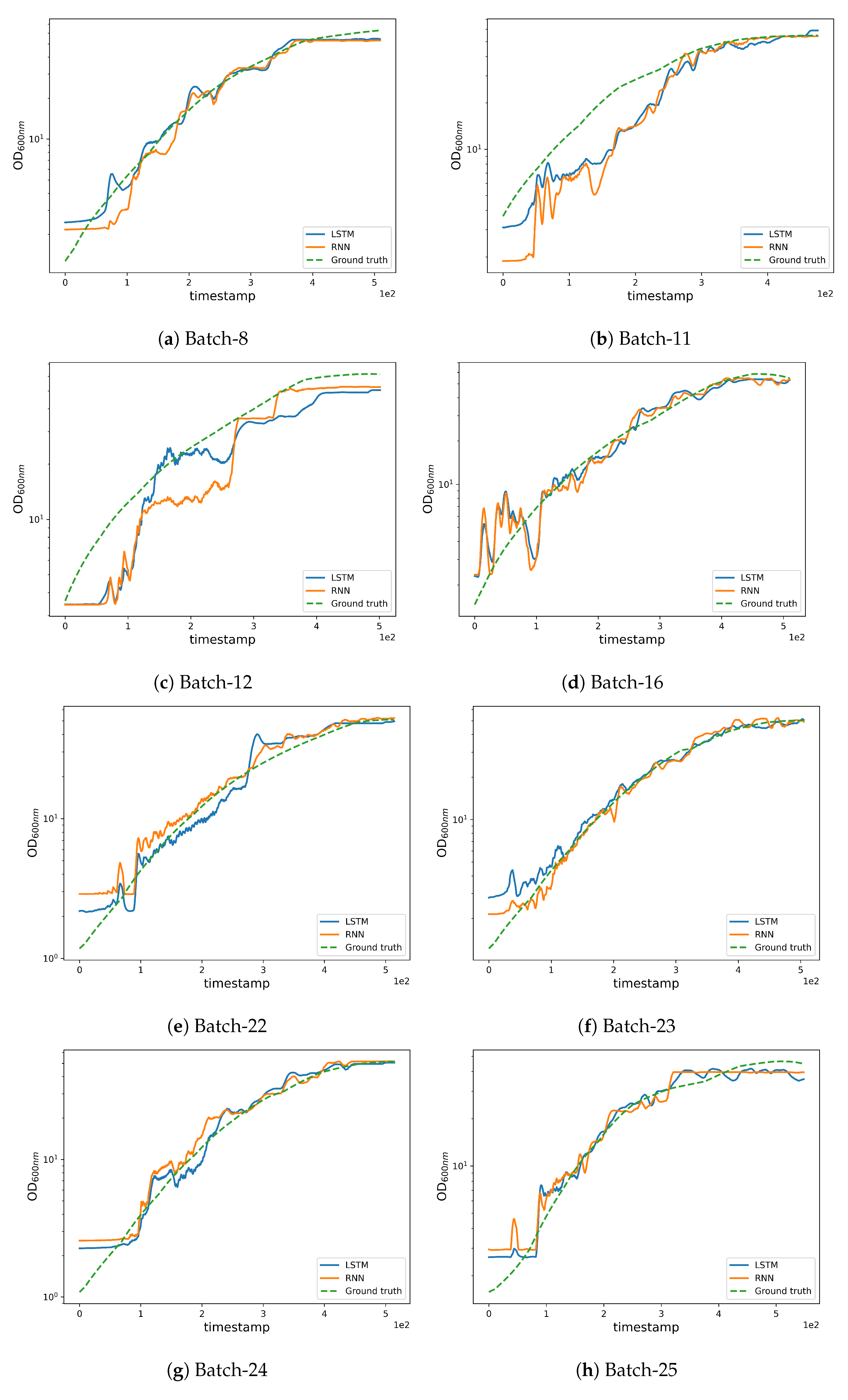
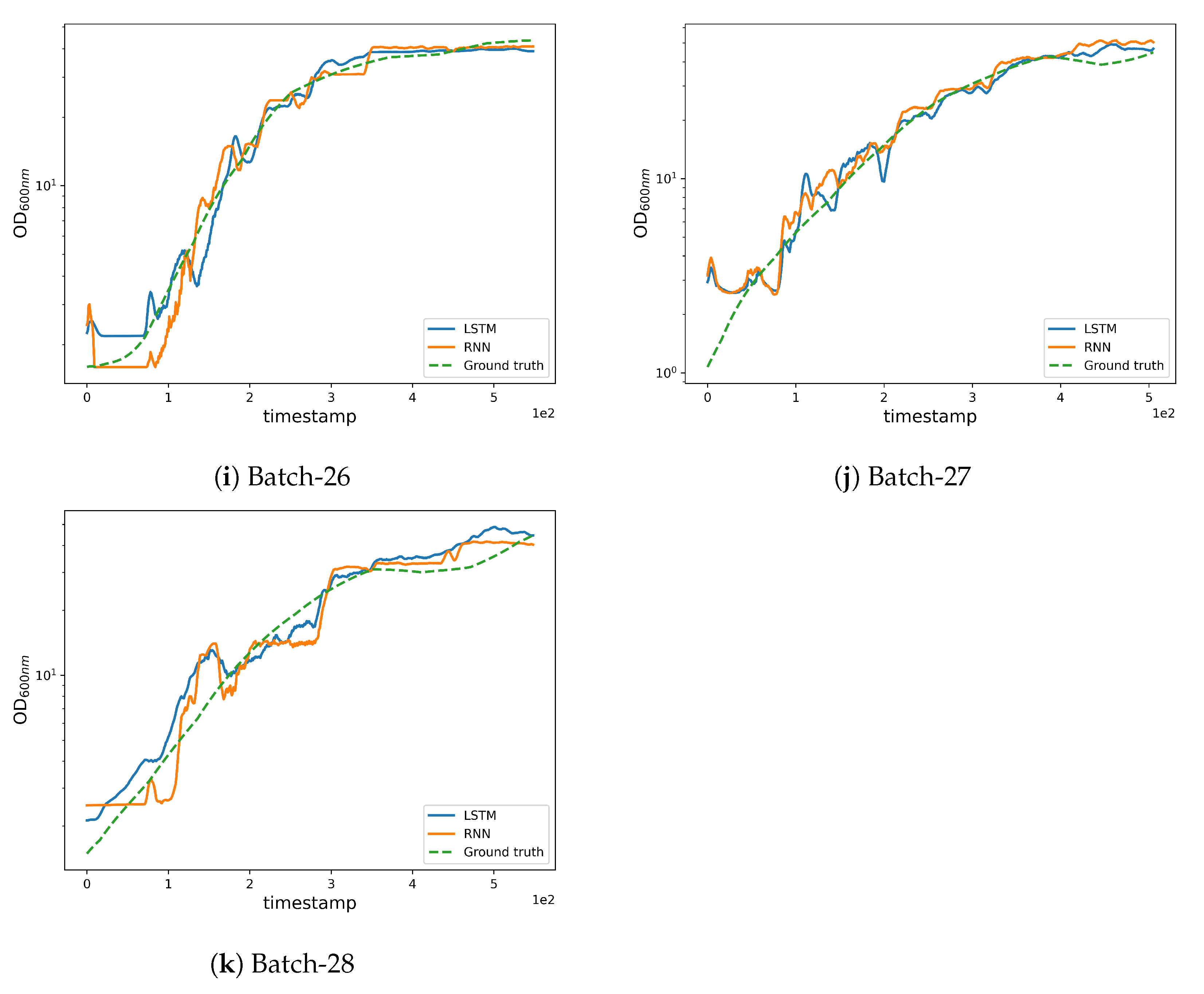
| Run | Final OD600nm | Biomass (g) | IB (g) | Ratio OD600nm/IB |
|---|---|---|---|---|
| 8 | 63.4 | 66.6 | 13.5 | 4.7 |
| 11 | 55 | 54.4 | 12 | 4.6 |
| 12 | 62.7 | 59.3 | 12 | 5.2 |
| 16 | 56 | 51 | 10.8 | 5.2 |
| 22 | 51.1 | 53.6 | 10 | 5.1 |
| 23 | 50.5 | 58.4 | 12.4 | 4.1 |
| 24 | 52 | 53.9 | 10.1 | 5.1 |
| 25 | 50.3 | 302 | NA | NA |
| 26 | 55.6 | 301.1 | NA | NA |
| 27 | 44.6 | 66.3 | NA | NA |
| 28 | 32.4 | 69.3 | NA | NA |
| Critical Process Parameters (CPP) | Unit | Nomenclature |
|---|---|---|
| pH | unit | m_pH |
| Dissolved Oxygen | % | m_ls_opt_do |
| Temperature | °C | m_temp |
| Stirrer | rpm | m_stirrer |
| Pure Oxygen | L | dm_o2 |
| Compressed Air | L | dm_air |
| Pump 1 (Base) | Rpm | dm_spump1 |
| Pump 2 (Acid) | Rpm | dm_spump2 |
| Pump 3 (Antifoam) | Rpm | dm_spump3 |
| Pump 4 (Feed) | Rpm | dm_spump4 |
| Induction | Binary | induction |
| Hyperparameter | Value |
|---|---|
| Input size | 11 |
| Time sequence length | 20 |
| Stride | 5 |
| Latent space size | 16 |
| Number of recurrent layers | 2 |
| Batch | RMSE | REFY (%) | Final Yield | ||
|---|---|---|---|---|---|
| LSTM | RNN | LSTM | RNN | Ground Truth | |
| 8 | 3.26 | 3.50 | 13.68 | 15.74 | 62.83 |
| 11 | 7.08 | 7.22 | 7.85 * | 1.24 | 54.84 |
| 12 | 9.18 | 8.20 | 18.15 | 15.03 | 61.69 |
| 16 | 3.53 | 3.16 | 3.07 | 1.62 | 54.72 |
| 22 | 4.08 | 2.89 | 2.39 | 3.16 * | 50.83 |
| 23 | 1.63 | 2.34 | 0.47 * | 2.41 | 50.31 |
| 24 | 2.47 | 2.52 | 1.87 | 0.18 * | 51.51 |
| 25 | 3.85 | 3.84 | 20.10 | 11.58 | 44.72 |
| 26 | 2.13 | 2.17 | 10.56 | 6.07 | 43.57 |
| 27 | 3.01 | 4.36 | 4.31 * | 12.63 * | 44.75 |
| 28 | 4.90 | 3.85 | 0.31 | 9.61 | 44.58 |
| avg. | 4.10 | 4.00 | 7.52 | 7.21 | 51.30 |
Disclaimer/Publisher’s Note: The statements, opinions and data contained in all publications are solely those of the individual author(s) and contributor(s) and not of MDPI and/or the editor(s). MDPI and/or the editor(s) disclaim responsibility for any injury to people or property resulting from any ideas, methods, instructions or products referred to in the content. |
© 2023 by the authors. Licensee MDPI, Basel, Switzerland. This article is an open access article distributed under the terms and conditions of the Creative Commons Attribution (CC BY) license (https://creativecommons.org/licenses/by/4.0/).
Share and Cite
Bonanni, D.; Litrico, M.; Ahmed, W.; Morerio, P.; Cazzorla, T.; Spaccapaniccia, E.; Cattani, F.; Allegretti, M.; Beccari, A.R.; Del Bue, A.; et al. A Deep Learning Approach to Optimize Recombinant Protein Production in Escherichia coli Fermentations. Fermentation 2023, 9, 503. https://doi.org/10.3390/fermentation9060503
Bonanni D, Litrico M, Ahmed W, Morerio P, Cazzorla T, Spaccapaniccia E, Cattani F, Allegretti M, Beccari AR, Del Bue A, et al. A Deep Learning Approach to Optimize Recombinant Protein Production in Escherichia coli Fermentations. Fermentation. 2023; 9(6):503. https://doi.org/10.3390/fermentation9060503
Chicago/Turabian StyleBonanni, Domenico, Mattia Litrico, Waqar Ahmed, Pietro Morerio, Tiziano Cazzorla, Elisa Spaccapaniccia, Franca Cattani, Marcello Allegretti, Andrea Rosario Beccari, Alessio Del Bue, and et al. 2023. "A Deep Learning Approach to Optimize Recombinant Protein Production in Escherichia coli Fermentations" Fermentation 9, no. 6: 503. https://doi.org/10.3390/fermentation9060503
APA StyleBonanni, D., Litrico, M., Ahmed, W., Morerio, P., Cazzorla, T., Spaccapaniccia, E., Cattani, F., Allegretti, M., Beccari, A. R., Del Bue, A., & Martin, F. (2023). A Deep Learning Approach to Optimize Recombinant Protein Production in Escherichia coli Fermentations. Fermentation, 9(6), 503. https://doi.org/10.3390/fermentation9060503







